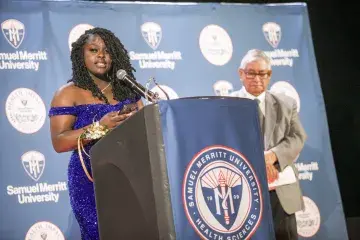5 Reasons Why People of Color Are Needed in Healthcare
Student Voices is a blog series written by SMU students. If you have an idea for a story, reach out to ssolo@samuelmerritt.edu. This article is written by Nensha Kamara, a first-year occupational therapy student.
Earlier this school year in my integrative seminar class, my fellow OT students and I had an inspired discussion about the importance of understanding healthcare disparities amongst those who are different from us. It was a problem based learning class, so we shared our ideas how to overcome the obstacles when you are a different gender, class, or ethnicity than your patient.
It was impressive to hear how differently each of us approached the problem.
And it was also in that class when I, an African American female, formed an appreciation of the learning environment instructors are creating at Samuel Merritt University.
Like many of my fellow students, I have volunteered in hospitals and clinics. But the unfortunate fact is that I have yet to work for, or with, another African American occupational therapist. And according to SMU admissions data, just two African American students were enrolled in SMU’s OT program in 2015-2016.
As OTs, we try to understand what is meaningful to our clients and how to help them reach their goals. If we look like the people we are working with, and have shared life and cultural experiences with them, then we are more likely to truly empathize and understand what is meaningful in their lives.
I appreciated the seminar discussion, but I also wanted to dig deeper — one class was not enough. I learned from reading Disparities in Health and Health Care: Five Key Questions and Answers that in within the next 30 years, people of color will account for half of the population. Therefore, it is increasingly important to take a stance in addressing these issues, particularly as a person of color. Below are five quick reasons why I think it is important for people of color to become healthcare practitioners.
1. Resemble the communities we serve so there is a better connection.
As healthcare providers, we can appear intimidating for various reasons. If more of us resemble the communities we are working in, we will have better opportunities of building trust, deepening connections, and improving future outcomes.
2. Eliminate communication gaps.
If we can overcome communication barriers, we will have a better chance of giving our patients the basic understanding of what is necessary to live a healthy life. By limiting our assumptions about their situation, we learn to hear their individual needs, and become better listeners overall. This will enhance the client’s experience and increase satisfaction.
3. Advocate for equality.
We are trying to reduce health disparities, and by taking a job in healthcare, we are taking one step toward lifting up the underserved. A diverse healthcare workforce improves health outcomes for all patients.
4. End stigmas against those who face barriers.
By working with individuals who look different, practice a particular religion, or identify with a certain group, we diminish the preconceived notion that these individuals do not deserve quality care. Broadening access to prominent healthcare for all will eliminate the cycle of poor healthcare outcomes, and any associated stigma.
5. Show the youth that we are in prominent, respected positions.
It’s encouraging when you have someone who looks like you to aspire to. Healthcare practitioners can be trusted leaders in their communities; if the next generation sees us in these positions, they’ll know they can do it to.
Although I was a bit disappointed to see that are only two African American students in my OT cohort, I appreciate the work SMU is doing to diversify the campus and improve health outcomes. The support is refreshing, and the fact that there are people like me here, who are equally concerned with improving health care outcomes for all is a step in the right direction.


